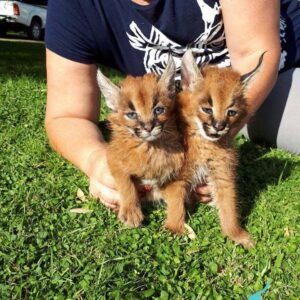Caracal kittens for sale
Caracal kittens are the offspring of caracals, which are medium-sized wild cats native to Africa, the Middle East, Central Asia, and parts of India and Pakistan. Female caracals care for their kittens until they are around a year old, after which the kittens leave to establish their own territories. Caracals typically give birth to a litter of one to six kittens after a gestation period of two to three months. Kittens are born blind and deaf, and their eyes open around 10 days old. They are weaned at 10 weeks and can leave their mothers at around nine to ten months of age.
Physical Characteristics
Caracal kittens are known for their unique and distinctive physical features. They are medium-sized cats, with males weighing between 13-18 kilograms and females weighing slightly less. One of the most striking features of caracal kittens is their tufted ears, which are long and pointed, giving them a regal appearance. These tufts of hair on their ears serve both practical and aesthetic purposes. They enhance their hearing abilities, allowing them to detect even the faintest sounds, and also serve as a visual signal to communicate with other caracals.
The fur of caracal kittens is short and dense, providing them with excellent insulation in their natural habitat. Their coat color varies from reddish-brown to tawny, with some individuals displaying faint spots or stripes. This camouflage helps them blend seamlessly into their surroundings, making them efficient hunters. Their eyes are large and amber-colored, providing them with excellent vision, especially during low-light conditions. Overall, the physical characteristics of caracal kittens make them perfectly adapted to their environment.
Habitat and Distribution
Caracal kittens are primarily found in the savannah regions of Africa, although their range extends into parts of the Middle East and India. They inhabit a variety of habitats, including grasslands, scrublands, and woodlands. These versatile felines are well-adapted to different environments and can thrive in both arid and semi-arid regions. Caracal kittens are solitary animals, and each individual caracal has its own territory, which it fiercely defends against intruders.
Behavior and Hunting Skills
Caracal kittens are known for their agility, speed, and impressive hunting skills. They are crepuscular animals, meaning they are most active during dawn and dusk. During the day, they rest in secluded spots, such as dense vegetation or rocky outcrops, to avoid the scorching heat. Caracal kittens are highly skilled hunters, capable of taking down prey much larger than themselves. Their diet mainly consists of small to medium-sized mammals, such as rodents, hares, and antelopes.
One of the most remarkable hunting techniques of caracal kittens is their ability to leap high into the air to catch birds in flight. They can jump up to 3 meters in the air, using their powerful hind legs and strong muscles. This acrobatic display of hunting prowess is a testament to their incredible athleticism and precision. Caracal kittens are also known for their excellent hearing, which allows them to locate and track their prey with remarkable accuracy.
Conservation Status and Threats
Despite their remarkable abilities and captivating presence, caracal kittens face numerous threats in the wild. Habitat loss, due to human encroachment and agricultural expansion, is one of the primary challenges they encounter. Deforestation and the conversion of natural habitats into farmland have resulted in the fragmentation of their territories, making it difficult for them to find suitable hunting grounds.
Another significant threat to caracal kittens is poaching. Their fur and body parts are highly valued in the illegal wildlife trade, leading to their targeted hunting. Additionally, caracal kittens are sometimes killed by farmers who perceive them as a threat to their livestock. These factors, combined with the overall decline in prey populations, pose a significant risk to the survival of caracal kittens in the wild.
Efforts are being made to conserve and protect caracal kittens and their habitats. Conservation organizations are working towards creating protected areas and implementing measures to reduce human-wildlife conflict. Public awareness campaigns are also crucial in educating communities about the importance of preserving these magnificent creatures and their ecosystems.


